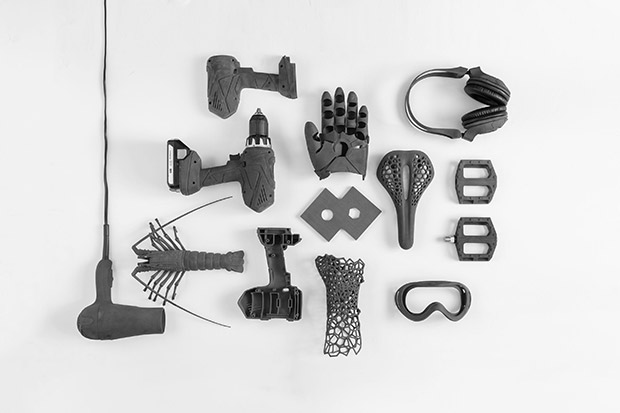Editor’s Pick: Benchtop Laser-Sintering 3D Printer Unveiled

During Fuse-1’s 3D-print process, parts are suspended in a bed of powder, which eliminates the need for supports and enables the printing of complex, intricate parts, such as those shown here. Image courtesy of Formlabs Inc.
Latest News
July 5, 2017
Formlabs is an interesting and ingenious outfit. They were one of the first, if not the first, to make desktop SLA (stereolithography) 3D printing with professional quality an economically viable technology for designers and engineers. They recently unveiled a couple of new products that seem to further solidify that inventive bent: the Fuse 1 and the Form Cell.
The Fuse 1 is the first selective laser sintering (SLS) 3D printer from Formlabs. It’ll be available in beta later this year and shipping in 2018. The projected price for a complete system with a bunch of extras is $20K. So what’s the scoop?
 The new benchtop-friendly Fuse 1, the first selective laser sintering (SLS) 3D printer from Formlabs, eliminates the need for build supports and can 3D print complex parts such as those shown here. Image courtesy of Formlabs Inc.
The new benchtop-friendly Fuse 1, the first selective laser sintering (SLS) 3D printer from Formlabs, eliminates the need for build supports and can 3D print complex parts such as those shown here. Image courtesy of Formlabs Inc.Well, it’s a benchtop unit with a roomy 6.5x6.5x12.6-in. build volume. There’s a nifty removable build chamber that can keep you printing continuously. It has networking and other neat stuff like a live video feed so that you can monitor and inspect builds.
The Fuse 1 makes functional prototypes and end-use parts with durable nylon materials. Its parts don’t need supports, so you can 3D print intricate and complex parts you might otherwise pass on with other technologies. The software lets you stack parts to maximize production runs. You can add new parts to an active build, and print with up to 50% recycled powder.
Although the Form 1 is for your benchtop, think of the Form Cell as your in-house additive manufacturing digital factory that can run 24/7.
The skinny on the Form Cell is that it’s a scalable grouping of 3D printers designed to parallelize and automate repetitive 3D printing processes. It groups together a row of Formlabs’ Form 2 SLA 3D printers as well as a cleaning and curing unit. It has an industrial robotic gantry system mounted above the printers that picks up, places and moves parts along.
The Form Cell’s software manages 3D print run schedules, and it handles part and serial number printing. It also provides error detection. You can monitor operations remotely, although constant check-ins are not required. There’s an API (application programming interface) so that you can link it in with your home-brewed business tools or platforms like ERP or MES (manufacturing execution system).
Both the Fuse 1 and the Form Cell sound pretty interesting. Today’s Editor’s Pick of the Week write-up has more details on each, including links that go to some short intro videos. Hit today’s link, poke around some and see what you think.
Thanks, Pal. – Lockwood
Anthony J. Lockwood
Editor at Large, DE
Subscribe to our FREE magazine, FREE email newsletters or both!
Latest News
About the Author
Anthony J. Lockwood is Digital Engineering’s founding editor. He is now retired. Contact him via [email protected].
Follow DE






